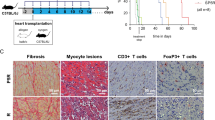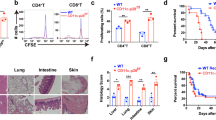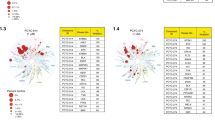Abstract
Recently, apoptosis has been considered to be an important regulator for allograft survival. The serine/threonine kinase Pim2 has been implicated in many apoptotic pathways. In a previous study, we found that pim2 was highly expressed in CD4+ T cells in an allograft model. Here, we further investigated the effects of Pim2 on allograft survival and the underlying mechanisms associated with apoptosis. The results showed that pim2 was overexpressed in grafts and spleens, particularly in spleen CD4+ T cells when acute allorejection occurred, and correlated positively with the extent of rejection. In T cells from the spleens of naive BALB/c mice treated with 5 µM 4a (a specific inhibitor of Pim2) for 24 h, the apoptosis rate increased and the phosphorylation of BAD was decreased. Furthermore, adoptive transfer of CD4+ T cells treated with 4a in vitro to allografted severe combined immunodeficiency (SCID) mice effectively prolonged allograft survival from 19.5±1.7 days to 31±2.3 days. Moreover, the results demonstrated that the CD4+CD25− effector T-cell subset was the predominate expresser of the pim2 gene as compared with the CD4+CD25+ regulatory T (Treg) cell subset. Alloantigen-induced CD4+CD25+ T cells displayed less Foxp3 expression and a low suppression of apoptosis compared with effector CD4+CD25− T cells treated with 4a. Collectively, these data revealed that Pim2 facilitated allograft rejection primarily by modulating the apoptosis of effector T cells and the function of Treg cells. These data suggested that Pim2 may be an important target for in vivo anti-rejection therapies and for the ex vivo expansion of CD4+CD25+ T cells.
This is a preview of subscription content, access via your institution
Access options
Subscribe to this journal
Receive 12 digital issues and online access to articles
$119.00 per year
only $9.92 per issue
Buy this article
- Purchase on Springer Link
- Instant access to full article PDF
Prices may be subject to local taxes which are calculated during checkout






Similar content being viewed by others
References
Spivey TL, Uccellini L, Ascierto ML, Zoppoli G, de Giorgi V, Delogu LG et al. Gene expression profiling in acute allograft rejection: challenging the immunologic constant of rejection hypothesis. J Transl Med. 2011; 9: 174.
Pallet N, Dieudé M, Cailhier J, Hébert M . The molecular legacy of apoptosis in transplantation. Am J Transplant 2012; 12: 1378–1384.
Bachmann M, Moroy T . The serine/threonine kinase PIM-1. Int J Biochem Cell Biol 2005; 37: 726–730.
Breuer ML, Cuypers HT, Berns A . Evidence for the involvement of PIM-2, a new common proviral insertion site, in progression of lymphomas. EMBO J 1989; 8: 743–748.
Mikkers H, Allen J, Knipscheer P, Romeijn L, Hart A, Vink E et al. High-throughput retroviral tagging to identify components of specific signaling pathways in cancer. Nat Gen 2002; 32: 153–159.
Alvarado Y, Giles FJ, Swords RT . The PIM kinases in hematological cancers. Expert Rev Hematol 2012; 5: 81–96.
Xia Z, Knaak C, Ma J, Beharry ZM, McInnes C, Wang W et al. Synthesis and evaluation of novel inhibitors of Pim-1 and Pim-2protein kinases. J Med Chem 2009; 52: 74–86.
Beharry Z, Zemskova M, Mahajan S, Zhang F, Ma J, Xia Z et al. Novel benzylidene-thiazolidine-2,4-diones inhibit Pim protein kinase activity and induce cell cycle arrest in leukemia and prostate cancer cells. Mol Cancer Ther 2009; 8: 1473–1483.
Issa F, Schiopu A, Wood KJ . Role of T cells in graft rejection and transplanttation tolerance. Expert Rev Clin Immunol 2010; 6: 155–169.
Rocha PN, Plumb TJ, Crowley SD, Coffman TM . Effector mechanisms in transplant rejection. Immunol Rev 2003; 196: 51–64.
Sakaguchi S, Sakaguchi N, Asano M, Itoh M, Toda M . Immunologic selftolerance maintained by activated T cells expressing IL-2 receptor alphachains (CD25). Breakdown of a single mechanism of self-tolerance causes various autoimmune diseases. J Immunol 1995; 155: 1151–1164.
Kaser T, Gerner W, Hammer SE Patzl M, Saalmüller A . Phenotypic and functional characterisation of porcine CD4+CD25high regulatory T cells. Vet Immunol Immunopathol 2008; 122: 153–158.
Golshayan D, Jiang S, Tsang J, Garin MI, Mottet C, Lechler RI . In vitro-expanded donor alloantigen-specific CD4+CD25+ regulatory T cells promote experimental transplantation tolerance. Blood 2007; 109: 827–835.
Basu S, Golovina T, Mikheeva T, June CH, Riley JL . Foxp3-mediated induction of pim2 allows human T regulatory cells to preferentially expand in rapamycin. J Immunol 2008; 180: 5794–5798.
Koyasu S . The role of PI3K in immune cells. Nat. Immunol 2003; 4: 313–319.
Fox CJ, Hammerman PS, Cinalli RM, Master SR, Chodosh LA, Thompson CB . The serine/threonine kinase Pim-2 is a transcriptionally regulated apoptotic inhibitor. Genes Dev 2003; 17: 1841–1854.
Tang Q, Bluestone JA . The Foxp3+ regulatory T cell: a jack of all trades, master of regulation. Nat Immunol 2008; 9: 239–244.
Nomura M, Plain KM, Verma N, Robinson C, Boyd R, Hodgkinson SJ et al. The cellular basis of cardiac allograft rejection. IX. Ratio of naive CD4+CD25+ T cells/CD4+CD25− T cells determines rejection or tolerance. Transpl Immunol 2006; 15: 311–318.
Golovina TN, Mikheeva T, Brusko TM, Blazar BR, Bluestone JA, Riley JL . Retinoic acid and rapamycin differentially affect and synergistically promote the ex vivo expansion of natural human T regulatory cells. PLoS One 2011; 6: e15868.
Hammerman PS, Fox CJ, Birnbaum MJ, Thompson CB . Pim and Akt oncogenes are independent regulators of hematopoietic cell growth and survival. Blood 2005; 105: 4477–4483.
Fox CJ, Hammerman PS, Thompson CB . The Pim kinases control rapamycin-resistant T cell survival and activation. J Exp Med 2005; 201: 259–266.
Aho TL, Lund RJ, Ylikoski EK, Matikainen S, Lahesmaa R, Koskinen PJ . Expression of human pim family genes is selectively up-regulated by cytokines promoting T helper type 1, but not T helper type 2 cell differentiation. Immunology 2005; 116: 82–88.
Xu J, Wang D, Zhang C, Song J, Liang T, Jin W et al. Alternatively expressed genes identified in the CD4+ T cells of allograft rejection mice. Cell Transpl 2011; 20: 333–350.
Learn CA, Fecci PE, Schmittling RJ, Xie W, Karikari I, Mitchell DA et al. Profiling of CD4+, CD8+, and CD4+CD25+CD45RO+FoxP3+ T cells in patients with malignant glioma reveals differential expression of the immunologic transcriptome compared with T cells from healthy volunteers. Clin Cancer Res 2006; 12: 7306–7315.
Sugimoto N, Oida T, Hirota K, Nakamura K, Nomura T, Uchiyama T et al. Foxp3-dependent and-independent molecules specific for CD25+CD4+ natural regulatory T cells revealed by DNAmicroarray analysis. Int Immunol 2006; 18: 1197–1209.
Zheng Y, Josefowicz SZ, Kas A, Chu TT, Gavin MA, Rudensky AY . Genome-wide analysis of Foxp3 target genes in developing andmature regulatory T cells. Nature 2007; 445: 936–940.
Macintyre AN, Finlay D, Preston G, Sinclair LV, Waugh CM, Tamas P et al. Protein kinase B controls transcriptional programs that directcytotoxic T cell fate but is dispensable for T cell metabolism. Immunity 2011; 34: 224–236.
Vander Lugt NM, Domen J, Verhoeven E, Linders K, van der Gulden H, Allen J et al. Proviral tagging in E mu-myc transgenic mice lacking the Pim-1 proto-oncogene leads to compensatory activation of Pim-2. Embo J 1995; 14: 2536–2544.
Yan B, Zemskova M, Holder S, Chin V, Kraft A, Koskinen PJ et al. The PIM-2 kinase phosphorylates BAD on serine 112 andreverses BAD-induced cell death. J Biol Chem 2003; 278: 45358–45367.
Muller YD, Golshayan D, Ehirchiou D, Wekerle T, Seebach JD, Bühler LH . T regulatory cells in xenotransplantation. Xenotransplantation 2009; 16: 121–128.
Acknowledgements
This work was supported by grants from the National Natural Science Foundation of China (No. 81071172, G. Hou) and the Natural Science Foundation of Shandong Province (No. ZR2010CM025, G. Hou).
Author information
Authors and Affiliations
Corresponding author
Rights and permissions
About this article
Cite this article
Liu, H., Zhang, C., Liang, T. et al. Inhibition of Pim2-prolonged skin allograft survival through the apoptosis regulation pathway. Cell Mol Immunol 9, 503–510 (2012). https://doi.org/10.1038/cmi.2012.41
Received:
Revised:
Accepted:
Published:
Issue Date:
DOI: https://doi.org/10.1038/cmi.2012.41
Keywords
This article is cited by
-
Heme oxygenase-1-transduced bone marrow mesenchymal stem cells in reducing acute rejection and improving small bowel transplantation outcomes in rats
Stem Cell Research & Therapy (2016)
-
rFliC prolongs allograft survival in association with the activation of recipient Tregs in a TLR5-dependent manner
Cellular & Molecular Immunology (2014)



